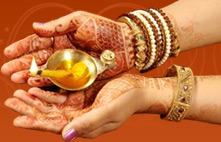Dol-Purnima (Rang Panchami), the festival of colour is celebrated with great festivity and joy. On this day, people come out wearing pure white clothes and gather together in a common place where they play it with gay abandon.
Punjab
In Punjab Sikhs celebrate a similar festival known as Hola Mohalla. It was started to oppose playing holi in religion.Fighting practice is done on this day.
Lath mar Holi being played in Barsana, Uttar Pradesh
Uttar Pradesh
Barsana is the place to be at the time of Holi. Here the famous Lath mar Holi is played in the sprawling compound of the Radha Rani temple. Thousands gather to witness the Lath Mar holi when women beat up men with sticks as those on the sidelines become hysterical, sing Holi Songs and shout Sri Radhey or Sri Krishna. The Holi songs of Braj mandal are sung in pure Braj Bhasha.
Holi played at Barsana is unique in the sense that here women chase men away with sticks. Males also sing provocative songs in a bid to invite the attention of women. Women then go on the offensive and use long staves called lathis to beat men folk who protect themselves with shields.
In Mathura, the birth place of Lord Krishna, and in Vrindavan this day is celebrated with special puja and the traditional custom of worshipping Lord Krishna, here the festival last for sixteen days. All over the Braj region and its nearby places like Hathras, Aligarh, Agra the Holi is celebrated in more or less same way as in Mathura, Vrindavan and Barsana.
In Gorakhpur, the northeast district of Uttar Pradesh, this day is celebrated with special puja in the morning of Holi day. This day is considered to be the happiest and colorful day of the year promoting the brotherhood among the people. This is known as “Holi Milan” in which people visit every house and sing holi song and express their gratitude by applying colored powder (Abeer). Holi is also considered as the end of the year as it occurs on the last day of last Hindu calendar month Phalgun. People also kickoff for the next year planning with new year Hindu calendar (Panchang) at the evening of Holi.
Holi celebrations, Pushkar, Rajasthan.
Bihar
Holi is celebrated with the same fervour and charm in Bihar as in rest of north India. It is known as Phagwa in the local Bhojpuri dialect. Here too, the legend of Holika is prevalent. On the eve of Phalgun Poornima, people light bonfires. They put dung cakes, wood of Araad or Redi tree and Holika tree, grains from the fresh harvest and unwanted wood leaves in the bonfire. Following the tradition people also clean their houses for the day.
At the time of Holika people assemble near the fire. The eldest member or a purohit initiates the lighting. He then smears others with colour as a mark of greeting. Next day the festival is celebrated with colours and lot of frolic.
Children and youths take extreme delight in the festival. Though the festival is usually played with colours at some places people also enjoy playing holi with mud. Folk songs are sung at high pitch and people dance to the tune of dholak and the spirit of Holi.
Intoxicating bhang is consumed with a variety of mouth watering delicacies such as pakoras and thandai to enhance the mood of the festival. Vast quantities of liquor are consumed alongside ganja and bhang, which is sometimes added to foodstuffs.
Bengal
On the Dol Purnima day in the early morning, the students dress up in saffron-coloured clothes and wear garlands of fragrant flowers. They sing and dance to the accompaniment of musical instruments like ektara, dubri, veena, etc. Holi is known by the name of ‘Dol Jatra’, ‘Dol Purnima’ or the ‘Swing Festival’. The festival is celebrated in a dignified manner by placing the idols of Krishna and Radha on a picturesquely decorated palanquin which is then taken round the main streets of the city or the village. The devotees take turns to swing them while women dance around the swing and sing devotional songs. All this while men keep spraying coloured water and coloured powder, abir, at them.
The head of the family, observes fast and prays to Lord Krishna and Agnidev. After all the traditional rituals are over, he smears Krishna’s idol with gulal and offers “bhog” to both Krishna and Agnidev.
In Shantiniketan, holi has a special musical flavour.
Traditional dishes include malpoa, kheer sandesh, basanti sandesh(of saffron),saffron milk, payash,etc.
Orissa
The people of Orissa celebrate Holi in a similar manner but here the idols of Jagannath, the deity of the Jagannath Temple of Puri, replace the idols of Krishna and Radha.
Goa
Holi is a part of Goan or Konkani spring festival known as Sigmo or ????? in Ko?ka?i .One of the most prominent festivals of the Konkani community in Goa,and the Konkani diaspora in the state of Karnataka,Maharashtra and Kerala.Sigmo is also known as Sisirotsava lasts for about a month,the color festival or Holi is a part of entire spring festival celebrations.
Holi festivities(not Sigmo festivities),include:Holika Puja and Dahan,Dhulvad or Dhuli vandan,Haldune or offering yellow and saffron colour or Gulal to the deity.
Main article: Shigmo
Gujarat
Festival of colours, Holi is celebrated with great fanfare in the Indian state of Gujarat. Falling on the full moon day in the month of Phalguna, Holi is a major Hindu festival and marks the agricultural season of the Rabi crop.
Bonfire is also lit in the main squares of the villages, localities and colonies. People collect at the time of bonfire and celebrate the event, which is symbolic of the victory of good over evil by singing and dancing. Tribals of Gujarat celebrate Holi in great enthusiasm and dance around the fire.
In Western India, Ahmedabad in Gujarat, a pot of buttermilk is hung high on the streets and young boys try to reach it and break it by making human pyramids while the girls try to stop them by throwing coloured water on them to commemorate the pranks of Krishna and cowherd boys to steal butter and ‘gopis’ trying to stop them. At this time the men soaked with colours go out in large procession to mock alert people of the Krishna who might come to steal butter in their homes. The boy who finally manages to break the pot is crowned the Holi King of the Year for that community.
At some places, there is a custom in the undivided Hindu families that the women of the families beat their brother-in-law with her sari rolled up into a rope in a mock rage as they try to drench them with colours and in turn the brother-in-law bring sweetmeats for her in the evening.
Maharashtra
In Maharashtra, Holi is mainly associated with the burning of Holika. Holi Paurnima is also celebrated as Shimga. A week before the festival, youngsters go around the locality, collecting firewood and money. On the day of Holi, the firewood is arranged in a huge pile at a clearing in the locality. In the evening, the fire is lit. Every household makes an offering of sweets and a complete meal to the fire god. Puran Poli is the main delicacy and children shout “Holi re Holi puranachi poli”. Shimga is associated with the elimination of all evil. Fun of playing with colours traditionally takes place on the day of Rangapanchami unlike North India where it is done on the second day itself.
Manipur
Manipuris celebrate Holi for six days. Introduced in the eighteenth century with Vaishnavism, it soon merged with the centuries-old festival of Yaosang. Traditionally, the festival commences with the burning of a thatched hut of hay and twigs. Young children go from house to house to collect money, locally known as nakadeng (or nakatheng), as gifts on the first two days. The youths at night perform a group folk dance called ‘thaabal chongba’ on the full moon night of Lamta (Phalgun) along with folk songs and rhythmic beats of the indigenous drum. However, this moonlight party now has modern bands and fluorescent lamps. In Krishna temples, devotees sing devotional songs, perform dances and play with aber (gulal) wearing traditional white and yellow turbans. On the last day of the festival, large processions are taken out to the main Krishna temple near Imphal where several cultural programmes are organized. Since the past few decades Yaoshang Sports has become common in many places of the valley, where people of all ages come out to participate in a number of ‘innovative’ sports!
South India
Holi celebrations at College of Engineering, Adoor Kerala
In Mattancherry area of Kochi, there are 22 different communities living together in harmony. Moreover, the Gaud Sarawat Brahmins (GSB) who speak Konkani also celebrate Holi in Cherlai area of West Kochi. They locally call it as Ukkuli in Konkani or Manjal Kuli in Malayalam. It is held around the majestic Konkani temple called Gosripuram Thirumala temple. This year Ukkuli will be celebrated on March 23, 2008 in Cherlai.Holi is also celebrated at some colleges in south.
Karnataka
Holi is celebrated with much fervour. Schools and colleges declare holiday that day and in Bangalore 2009 some MNC’s like Tata Consultancy Services and Cognizant Technology Solutions had declared holiday for Holi. Children, Adults alike play Holi. There is also a tradition followed in rural Karnataka, where children collect money and wood for weeks prior to Holi, and on Kamadhanam all the wood is put together and lighted.
Kashmir
Civilians as well as the Indian security force officers celebrate Holi in Kashmir. Holi, a high-spirited festival to mark the beginning of the harvesting of the summer crop, is marked by the throwing of coloured water and powder and singing and dancing.
Holi celebrations by the India Student Association at University of New Mexico
Haryana, Rural Delhi & West UP
The region also has its own variety of Holi, the festival is celebrated with great jest and enthusiasm. Dhampur is a city and a municipal board in Bijnor district in the state of Uttar Pradesh, India. Holi of Dhampur is famous in whole Western UP. http://en.wikipedia.org/wiki/Dhampur In Dhampur holi–holi hawan jaloos have been organised since last 60 years.It Involves almost 10,000 People participating with lots of Bands and Jhakhi which shows the cultural values of Holi.
Indian diaspora
Over the years, Holi has become an important festival in many regions wherever Indian diaspora had found its roots, be it in Africa, North America, Europe and closer home in South Asia.


